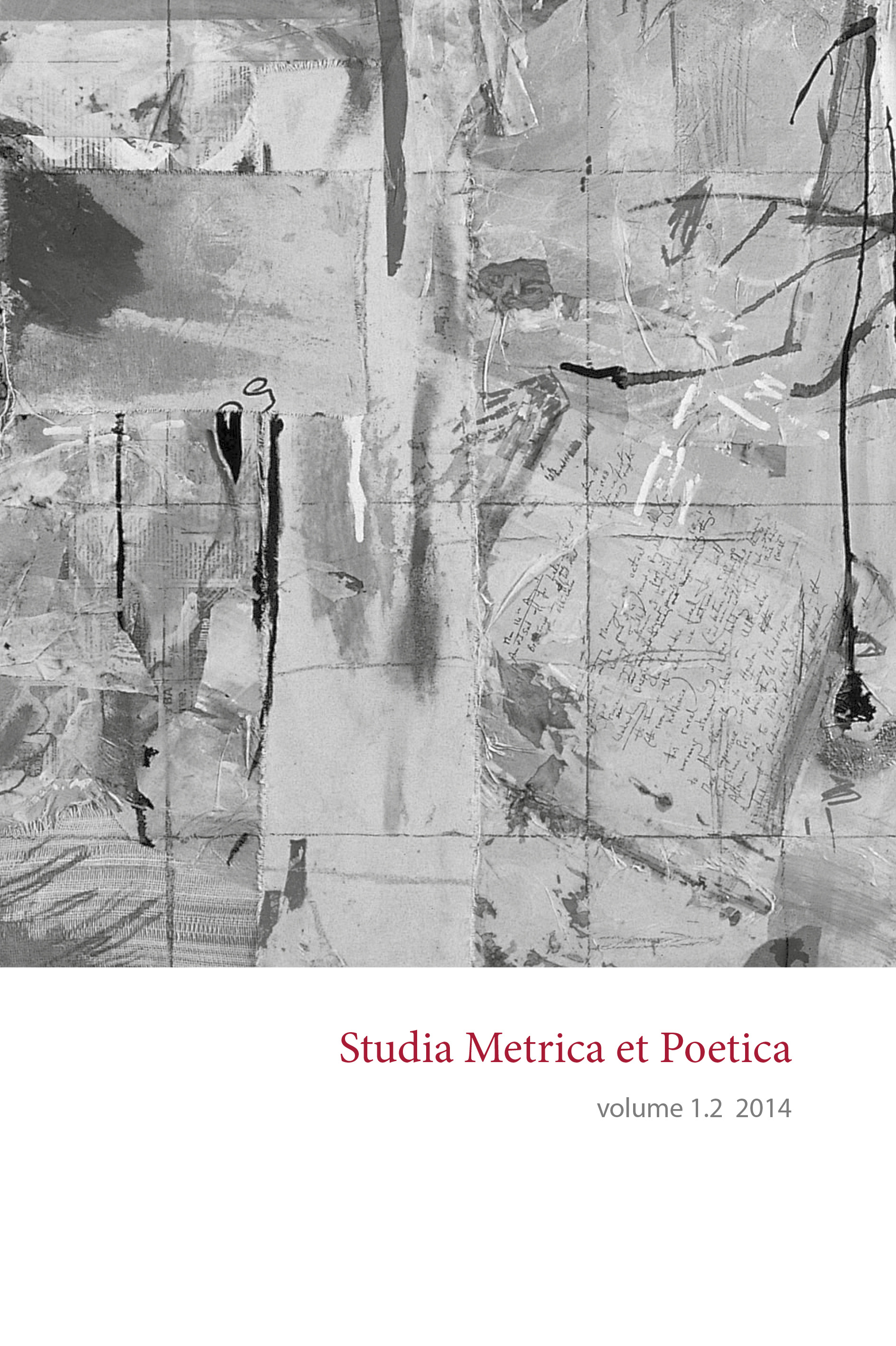Metrical Positions and their Linguistic Realisations in Old Germanic Metres: A Typological Overview
DOI:
https://doi.org/10.12697/smp.2014.1.2.02Keywords:
Old Germanic metre, metrical positions, typology, Beowulf, Heliand, fornyrðislag, málaháttr, ljóðaháttrAbstract
This paper provides a typological account of Old Germanic metre by investigating its parametric variations that largely determine the metrical identities of the Old English Beowulf, the Old Saxon Heliand, and Old Norse eddic poetry (composed in fornyrðislag, málaháttr, or ljóðaháttr). The primary parameters to be explored here are the principle of four metrical positions per verse and the differing ways in which these constituent positions are aligned to linguistic material. On the one hand, the four-position principle works with a maximal strictness in Beowulf, and to a slightly lesser extent in fornyrðislag, whereas it allows for a wider range of deviations in verse size in the Heliand and ljóðaháttr. In málaháttr, however, the principle in itself gives way to the five-position counterpart. On the other hand, the variation in the metrical– linguistic alignment in the three close cognate metres may be generalised by positing the common scale, Heliand > Beowulf > fornyrðislag, for the decreasing likelihood of resolution, the increasing likelihood of suspending resolution, and the decreasing size of the drop.Downloads
Download data is not yet available.
References
<div class="WordSection1"><p>Anderson, Stephen R. 2011. Clitics. In: Oostendorp, Marc van; Ewen, Colin J.; Hume, Elizabeth; Rice, Keren (eds.) 2011. <em>Th</em><em>e</em><em> </em><em>Blackwell</em><em> </em><em>Companion</em><em> </em><em>to</em><em> </em><em>Phonology</em>, Vol. IV: <em>Phonological</em><em> Interfaces</em>. Malden, Mass.: Wiley-Blackwell, 2002–2018.</p><p>Aroui, Jean-Louis; Arleo, Andy 2009. <em>Towards a Typology of Poetic Forms: From Language to Metrics and Beyond</em>. Amsterdam: Benjamins. <a href="http://dx.doi.org/10.1075/lfab.2" target="_blank">http://dx.doi.org/10.1075/lfab.2</a></p><p>Axboe, Morten 2004. <em>Die Goldbrakteaten der Völkerwanderungszeit: Herstellungsprobleme und Chronologie </em>(Ergänzungsbände zum Reallexikon der Germanischen Altertumskunde 38). Berlin: De Gruyter. <a href="http://dx.doi.org/10.1515/9783110926460" target="_blank">http://dx.doi.org/10.1515/9783110926460</a></p></div><div class="WordSection2"><p>Behaghel, Otto; Taeger, Burkhard (eds.) 1996. <em>Heliand</em><em> </em><em>und</em><em> </em><em>Genesis.</em><em> </em>10th edn. Tübingen: Niemeyer.</p><p>Behr, Charlotte 2011. Forschungsgeschichte. In: Heizmann, Wilhelm; Axboe, Morten (eds.), <em>Die Goldbrakteaten der Völkerwanderungszeit: Auswertung und Neufunde </em>(Ergänzungsbände zum Reallexikon der Germanischen Altertumskunde 40). Berlin: De Gruyter, 153–229. <a href="http://dx.doi.org/10.1515/9783110224122.153" target="_blank">http://dx.doi.org/10.1515/9783110224122.153</a></p><p>Bugge, Sophus; Sievers, Eduard 1891. Vocalverkürzung im Altnordischen. In: <em>Beiträge</em><em> </em><em>zur</em><em> Geschichte der deutschen Sprache und Literatur </em>15, 391–411.</p><p>Cable, Thomas 1974. <em>Th</em><em>e</em><em> </em><em>Meter</em><em> </em><em>and</em><em> </em><em>Melody</em><em> </em><em>of</em><em> </em>Beowulf. Urbana: University of Illinois Press.</p><p>Cable, Thomas 1991. <em>The English Alliterative Tradition. </em>Philadelphia: University of Pennsylvania Press.</p><p>Connell, Bruce 2011. Downstep. In: Oostendorp et al., 824–847.</p><p>Fabb, Nigel; Halle, Morris 2008. <em>Meter</em><em> </em><em>in</em><em> </em><em>Poetry:</em><em> </em><em>A New Theory</em>. New York: Cambridge University Press. <a href="http://dx.doi.org/10.1017/CBO9780511755040" target="_blank">http://dx.doi.org/10.1017/CBO9780511755040</a></p><p>Fulk, R. D.; Bjork, Robert E.; Niles, John D. (eds.) 2008. <em>Klaeber’s Beowulf and the Fight at Finnsburg, </em>4th edn. Based on the third edition of <em>Beowulf and the Fight at Finnsburg, </em>ed. by Fr. Klaeber (1950). Toronto: University of Toronto Press.</p><p>Gussenhoven, Carlos 2004. <em>The</em><em> </em><em>Phonology</em><em> </em><em>of Tone and Intonation</em>. Cambridge: Cambridge University Press. <a href="http://dx.doi.org/10.1017/CBO9780511616983" target="_blank">http://dx.doi.org/10.1017/CBO9780511616983</a></p><p>Hayes, Bruce 1989. The prosodic hierarchy in meter. In: Kiparsky, Paul; Youmans, Gilbert (eds.), <em>Rhythm and Meter</em>. San Diego: Academic Press, 201–260. <a href="http://dx.doi.org/10.1016/B978-0-12-409340-9.50013-9" target="_blank">http://dx.doi.org/10.1016/B978-0-12-409340-9.50013-9</a></p><p>Lotz, John. 1960. Metric typology. In: Sebeok, Thomas A. (ed.), <em>Style in Language</em>. Cambridge, Mass.: MIT Press, 135–148.</p><p>Neckel, Gustav; Kuhn, Hans 1983. <em>Edda:</em><em> </em><em>Die</em><em> </em><em>Lieder</em><em> </em><em>des</em><em> </em><em>Codex</em><em> </em><em>Regius</em><em> </em><em>nebst</em><em> </em><em>verwandten</em><em> </em><em>Denkmälern</em>. 5th edn. Heidelberg: Winter.</p><p>Nespor, Marina; Vogel, Irene 1986. <em>Prosodic Phonology</em>. Dordrecht: Foris. Noreen, Adolf 1970. <em>Altnordische Grammatik I. </em>5th edn. Tübingen: Niemeyer.</p><p>Odden, David 1986. On the role of the obligatory contour principle in phonological theory. In: <em>Language </em>62, 353–383. <a href="http://dx.doi.org/10.2307/414677" target="_blank">http://dx.doi.org/10.2307/414677</a></p></div><p>Oostendorp, Marc van; Ewen, Colin J.; Hume, Elizabeth; Rice, Keren (eds.) 2011. <em>The Blackwell Companion to Phonology</em>, Vol. II, <em>Suprasegmental and Prosodic Phonology</em>. Malden, Mass.: Wiley-Blackwell.</p><p>Revithiadou, Anthi 2011. The phonological word. In: Oostendorp et al., 1204–1227. Russom, Geoffrey 1998. Beowulf <em>and Old Germanic Metre</em>. Cambridge: Cambridge University Press.</p><p>Sievers, Eduard 1893. <em>Altgermanische Metrik. </em>Halle: Niemeyer.</p><p>Suzuki, Seiichi 1996. <em>Th</em><em>e</em><em> </em><em>Metrical</em><em> </em><em>Organization</em><em> </em><em>of</em><em> </em>Beowulf: <em>Prototype</em><em> </em><em>and</em><em> </em><em>Isomorphism</em><em> </em>(Trends in Linguistics. Studies and Monographs 95). Berlin: De Gruyter; repr., 2011.</p><p>Suzuki, Seiichi 2004. <em>The Metre of Old Saxon Poetry: The Remaking of Alliterative Tradition. </em>Cambridge: Brewer.</p><p>Suzuki, Seiichi 2008. <em>Anglo-Saxon </em><em>Button Brooches: Typology, Genealogy, Chronology </em>(Anglo-Saxon Studies 10). Woodbridge: Boydell.</p><p>Suzuki, Seiichi 2014. <em>The Meters of Old Norse Eddic Poetry: Common Germanic Inheritance and North Germanic Innovation </em>(Ergänzungsbände zum Reallexikon der Germanischen Altertumskunde 86). Berlin: De Gruyter.</p>Wimsatt, William K. (ed.) 1972. <em>Versification: Major Language Types</em>. New York: Modern Language Association.


